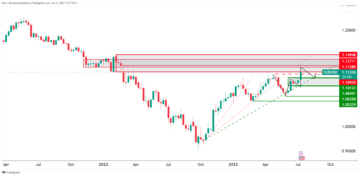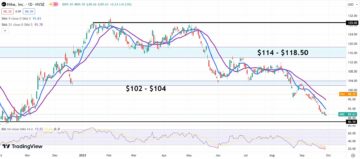
- The US Dollar soars on Tuesday after Asian markets set the scene for a stronger Greenback.
- Traders are letting the dust settle over the BoJ rate decision ahead of US housing data.
- The US Dollar Index briefly hit 104.00 before retreating a touch.
The US Dollar (USD) jumped firmly in the green on Tuesday, giving a big thank you to the Japanese Yen. The Yen, which accounts for roughly 13% of the US Dollar Index (DXY), depreciated nearly 1% against the Greenback after the Bank of Japan (BoJ) delivered a dovish interest-rate hike. The move away from negative interest rates was well communicated months in advance and came as no surprise to markets, resulting in a weaker Yen.
Meanwhile, the US economic data front was all about housing data on Tuesday. Both Building Permits and Housing Starts were better than expected ahead of the US Federal Reserve (Fed) rate decision on Wednesday. The Federal Open Market Committee (FOMC) starts its two-day meeting this Tuesday, and some further contraction in the US housing market could put June back on the table for that eagerly anticipated rate cut.
Daily digest market movers: Fed to ease
- In Asia overnight, the BoJ has hiked interest rates for the first time in almost two decades, to 0% from -0.10%. However, markets sent the Japanese Yen weaker after comments from BoJ Governor Kazuo Ueda that the BoJ will keep its monetary easing in place and that this is probably a one-and-done hike.
- In the aftermath of the BoJ rate decision, the Greenback and the Chinese Yuan benefited the most from the devaluing Yen.
- In Europe, European Central Bank Vice President Luis De Guindos said that June will be pivotal for the ECB rate decision. An initial rate cut is already a possibility at the June meeting.
- At 12:30 GMT, US Housing data was released:
- Housing Starts for February came in at 1.521 million, above the estimate of 1.425 million and beating the January number at 1.374 million.
- Building Permits for February jumped to 1.518 million, substantially higher than the 1.489 million from January.
- The US Treasury will be placing a 52-week bill in the market at 15:30 GMT.
- Equities are not reacting well to the dovish hike from the BoJ, with Europe and US indexes trading in the red after the US opening bell. Although the Dow is trying to recover.
- According to the CME Group’s FedWatch Tool, expectations for a Fed pause in the March 20 meeting are at 99%, while chances of a rate cut stand at 1%.
- The benchmark 10-year US Treasury Note trades around 4.30%, continuing its ascent from last week.
US Dollar Index Technical Analysis: Fed meeting to be less volatile
The US Dollar Index (DXY) is fading a touch after it briefly hit the 104.00 mark. Ahead of the US Federal Reserve meeting, this does not look the ideal place to be as markets will be looking for any dovish clues from Chairman Jerome Powell. Any dovish hint could mean that Tuesday’s move will be quickly pared back, with the DXY dropping back deep into 103.00 territory.
On the upside,104.96 remains the first level in sight. Once above there, the peak at 104.97 from February comes into play, ahead of the 105.00 region with 105.12 as the first resistance.
Expect some easing as the dust settles on the BoJ and ahead of the Fed meeting on Wednesday. Some support should come in from the 200-day Simple Moving Average (SMA) at 103.70, the 100-day SMA at 103.60 and the 55-day SMA at 103.50. The 103-area, thus, looks well equipped and covered with support levels to catch any retreats in the DXY.
Dot Plot FAQs
The “Dot Plot” is the popular name of the interest-rate projections by the Federal Open Market Committee (FOMC) of the US Federal Reserve (Fed), which implements monetary policy. These are published in the Summary of Economic Projections, a report in which FOMC members also release their individual projections on economic growth, the unemployment rate and inflation for the current year and the next few ones. The document consists of a chart plotting interest-rate projections, with each FOMC member’s forecast represented by a dot. The Fed also adds a table summarizing the range of forecasts and the median for each indicator. This makes it easier for market participants to see how policymakers expect the US economy to perform in the near, medium and long term.
The US Federal Reserve publishes the “Dot Plot” once every other meeting, or in four of the eight yearly scheduled meetings. The Summary of Economic Projections report is published along with the monetary policy decision.
The “Dot Plot” gives a comprehensive insight into the expectations from Federal Reserve (Fed) policymakers. As projections reflect each official’s projection for interest rates at the end of each year, it is considered a key forward-looking indicator. By looking at the “Dot Plot” and comparing the data to current interest-rate levels, market participants can see where policymakers expect rates to head to and the overall direction of monetary policy. As projections are released quarterly, the “Dot Plot” is widely used as a guide to figure out the terminal rate and the possible timing of a policy pivot.
The most market-moving data in the “Dot Plot” is the projection of the federal funds rate. Any change compared with previous projections is likely to influence the US Dollar (USD) valuation. Generally, if the “Dot Plot” shows that policymakers expect higher interest rates in the near term, this tends to be bullish for USD. Likewise, if projections point to lower rates ahead, the USD is likely to weaken.
- SEO Powered Content & PR Distribution. Get Amplified Today.
- PlatoData.Network Vertical Generative Ai. Empower Yourself. Access Here.
- PlatoAiStream. Web3 Intelligence. Knowledge Amplified. Access Here.
- PlatoESG. Carbon, CleanTech, Energy, Environment, Solar, Waste Management. Access Here.
- PlatoHealth. Biotech and Clinical Trials Intelligence. Access Here.
- Source: https://www.fxstreet.com/news/us-dollar-jumps-higher-after-bank-of-japan-delivers-dovish-hike-202403191239
- :has
- :is
- :not
- :where
- 00
- 1
- 10
- 12
- 15%
- 20
- 21
- 30
- 4
- 425
- 5
- 50
- 521
- 60
- 70
- 8
- 9
- 97
- a
- About
- above
- Accounts
- Adds
- advance
- After
- aftermath
- against
- ahead
- All
- almost
- along
- already
- also
- Although
- an
- analysis
- and
- Anticipated
- any
- ARE
- around
- AS
- ascent
- asia
- asian
- At
- average
- away
- back
- Bank
- bank of japan
- Bank of Japan (BoJ)
- Bank of Japan meeting
- BE
- before
- Bell
- Benchmark
- Better
- Big
- Bill
- boj
- BoJ rate decision
- both
- briefly
- Building
- Bullish
- by
- came
- CAN
- Catch
- central
- Central Bank
- chances
- change
- Chart
- checked
- chinese
- Chinese Yuan
- CME
- come
- comes
- comments
- committee
- communicated
- compared
- comparing
- comprehensive
- considered
- consists
- continuing
- contraction
- could
- covered
- Current
- Cut
- data
- de
- decades
- decision
- deep
- delivered
- Digest
- direction
- document
- does
- Dollar
- dollar index
- DOT
- Dovish
- dow
- Dropping
- Dust
- Dxy
- each
- eagerly
- Earlier
- easier
- easing
- ECB
- ECB rate decision
- Economic
- Economic growth
- economy
- eight
- end
- equipped
- estimate
- Europe
- European
- European Central Bank
- Every
- expect
- expectations
- expected
- FAQ
- February
- Fed
- fed meeting
- Federal
- Federal Funds Rate
- Federal Open Market Committee
- federal reserve
- few
- Figure
- firmly
- First
- first time
- FOMC
- For
- Forecast
- forecasts
- forex
- forward-looking
- four
- from
- front
- funds
- further
- Gains
- generally
- gives
- Giving
- GMT
- Governor
- Green
- Greenback
- Group’s
- Growth
- guide
- head
- higher
- Hike
- hint
- Hit
- housing
- housing market
- How
- However
- HTTPS
- ideal
- if
- implements
- in
- index
- indexes
- Indicator
- individual
- inflation
- influence
- initial
- insight
- interest
- Interest Rates
- into
- IT
- ITS
- January
- Japan
- Japanese
- Japanese Yen
- jerome
- jpg
- jumped
- june
- Keep
- Key
- Last
- less
- letting
- Level
- levels
- likely
- likewise
- Long
- Look
- looking
- LOOKS
- lower
- Luis de Guindos
- MAKES
- March
- mark
- Market
- Markets
- mean
- medium
- meeting
- meetings
- Members
- million
- Monetary
- Monetary Policy
- months
- most
- move
- Movers
- moving
- moving average
- name
- Near
- nearly
- negative
- next
- no
- note
- number
- of
- on
- once
- ones
- open
- opening
- or
- Other
- out
- over
- overall
- overnight
- participants
- pause
- Peak
- perform
- permits
- Pivot
- pivotal
- Place
- placing
- plato
- Plato Data Intelligence
- PlatoData
- Play
- plot
- Point
- policy
- policymakers
- Popular
- possibility
- possible
- president
- previous
- probably
- Projection
- projections
- published
- Publishes
- put
- quickly
- range
- Rate
- Rates
- reacting
- Recover
- Red
- reflect
- region
- release
- released
- remains
- report
- represented
- Reserve
- Resistance
- resulting
- roughly
- Said
- scene
- scheduled
- see
- sent
- set
- settle
- settles
- settling
- should
- Shows
- Sight
- Simple
- SMA
- Soars
- some
- stand
- starts
- stronger
- substantially
- SUMMARY
- support
- support levels
- surprise
- table
- Technical
- Technical Analysis
- tends
- term
- Terminal
- territory
- than
- thank
- that
- The
- the Fed
- The US Federal Reserve
- their
- There.
- These
- this
- Thus
- time
- timing
- to
- tool
- touch
- trades
- Trading
- treasury
- trying
- Tuesday
- two
- unemployment
- unemployment rate
- Upside
- us
- US Dollar
- US Dollar Index
- US economy
- US Federal
- us federal reserve
- US Housing
- US housing market
- US Treasury
- USD
- used
- v1
- Valuation
- vice
- Vice President
- volatile
- was
- weaker
- Wednesday
- week
- WELL
- were
- which
- while
- widely
- will
- with
- year
- yearly
- Yen
- you
- Yuan
- zephyrnet












